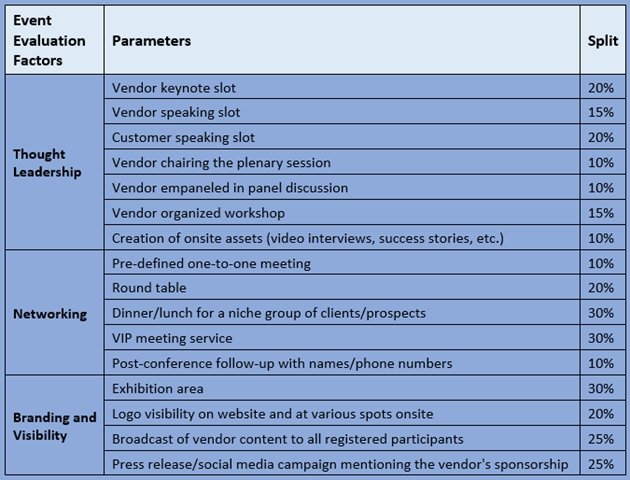One of the oldest yet most powerful means of reaching out to your target audience is event marketing. But, unlike digital marketing, which is the talk of the town these days, events necessitate much more preparation and incur greater costs to execute, and there are no ready metrics to determine whether the ROI of the event was positive.
Nevertheless, many marketers want to either hold their own event or participate in industry or analyst events. Why? The rationale behind what makes an event a trusted medium despite all the overhead is simple: Unlike most any other medium, events provide a near assurance that you have your potential customer's attention, in person, one on one.
But there are a plethora of events happening around the world every single day, and with events consuming at least a quarter of a company's marketing budget, the key question that arises is this: Which event is the right event, and is it worth spending those valuable dollars on event X or event Y?
To help marketers find their answer, this article shares the Event Evaluation Matrix—a tool that can help you gauge which is the right event for your marketing efforts.
The Event Evaluation Matrix
Next time you are investing in an event, check whether the event provides ample opportunities in three critical areas so you can determine whether it has high lead-generation potential:
- Thought leadership opportunities (Y-axis): The event's ability to provide ample opportunities for the vendor to demonstrate its domain leadership and expertise—the opportunity for the vendor to "pull" clients by showcasing intellectual gravitas
- Networking opportunities (X-axis): The event's ability to provide ample opportunities to connect with the right stakeholders—the opportunity for the vendor to "push" the message spot on and generate leads
- Branding and visibility (size of the bubble): The event's effectiveness in providing enough visibility to generate top-of-the-mind recall for the vendor's brand

See the table at the end of the article for how you might weight the various factors and parameters for your own event evaluation matrix.
The Three Evaluation Factors
1. Thought Leadership
B2B marketers understands the importance of showcasing thought leadership. Sharing helpful content builds credibility and breaks the entry barrier long before the actual sales cycle begin.
Although there are multiple ways to make your knowledge accessible to your audience, relying on events solves the last-mile problem and ensures that your clients know that you have something to say. And if you are interesting and knowledgeable enough, it creates the "pull" whereby potential clients reach out to you to learn more and engage with you.
Events provide several ways of showcasing your knowledge and expertise. While speaking in keynote slots ensures that you have the entire audience, client speaking slots substantiate your claim and offering. You can even run a workshop and tailor your content to a certain niche group. Other ways are participation in high-visibility panel discussions, creation and use of on-site assets like videos, etc.
Which spot the vendor grabs serves as a key factor of event effectiveness. For example, which of these might have a higher probability that you are heard: a 10 AM slot on Day 1, or a post-lunch session on a Day 3?
2. Networking
Events provide you valuable "face time" with a lot of people—all in a span of 2-3 days. It provides an opportunity whereby deeper relationships can be forged not just with your clients and prospects but with industry experts, partners, and influencers as well. You get a chance to "push" a customized message on the spot and create significant momentum to take the buyer journey to the next level.
Two important parameters will help determine whether the event will be a worthwhile for networking:
A. Type of Audience
Think of the suitability of your audience along these lines:
- Are there enough clients and prospects that you want to target?
- Are any analysts participating? Are there any professors or people from renowned industry associations or organizations?
- Who among your competitors are participating, and what is their sponsorship level?
A tip: ask the event organizer for the attendee list from the previous couple of years. Although audience varies from year to year, you'll gain a basic idea whether it would be wise to put your dollars in that basket.
B. Type of Networking Opportunity
As in the case of thought leadership, the type of networking opportunity that an event provides has a lot of impact on whether you will be able to build significant connections.
Events provide various options for having space and time with your desired audience: one-to-one meetings, round tables, dinner/lunch for a niche group of clients/prospects,VIP meeting services, etc. Some event organizers even facilitate networking and arrange meetings or have mobile apps to ensure easier connect.
Which of these opportunities you should choose depends on your event objective, but how well you are able to leverage them will determine event effectiveness.
3. Branding and Visibility
An event would serve its purpose if it were to succeed in helping to keep you top-of-mind among potential clients. The idea here isn't to make your prospect reach out to you immediately after an event, but to ensure they later remember you—before anyone else—when they actually feel the need for a service/solution.
The most important branding and visibility opportunity is the exhibition area. Factors like size of your demo station, the right spot on the show floor, etc. determine whether you will be able to "pull" an audience toward you.
Some events also provide options for sponsoring a small section of the event, such as the coffee stall, or materials such as notebooks, keychains, etc., which helps ensure visibility of your brand.
Apart from onsite visibility of your brand, some events provide an opportunity to broadcast your content via the event's social media channels and they mention you as a sponsor in their press releases and other messaging. This is a good opportunity to expand your reach to target audiences.
However, the real test of branding is whether leads and prospects will remember you when it is the time for actual engagement.
Scoring Method
The following table illustrates the relative importance of the various parameter within each of the evaluation criteria. Judging an event based on these criteria can provide a fair idea of which event will be more effective.
The cumulative scores can be charted on the Event Evaluation Matrix graph, helping you gauge the right events for you—i.e., those with the highest lead potential.





